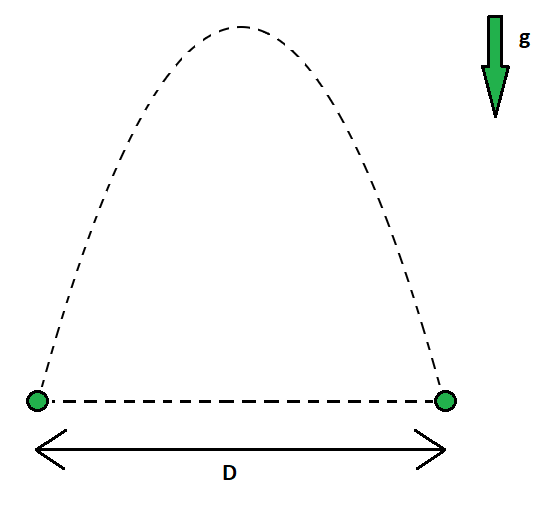A Straight Line Doesn't Minimize the Action

According to the Principle of Least Action , the path of a particle through space (given some caveats) is the path which minimizes the "action". Define the action as follows:
In the above formula, is the particle's kinetic energy and is the particle's potential energy. If a particle travels between two specific points in a definite amount of time , the path taken will be the one which minimizes the associated action .
Let's consider an example. Suppose we have two points with the same vertical position, which are separated horizontally by a distance . Suppose also that there is a downward (vertical) gravitational acceleration , with an associated potential. Consider a particle of mass traveling between these two points in a definite time . Evaluate the actions for the following two paths:
1)
A parabolic path consistent with standard kinematic principles (this is the path a real object would take)
2)
A straight-line, constant-velocity path from one point to the other
Assume that corresponds to the vertical position of the start and end points. The action for the straight-line path is greater than the action for the parabolic path by the following amount (hence, the parabolic path is favored):
Here, is a positive integer. Determine the value of .
The answer is 24.
This section requires Javascript.
You are seeing this because something didn't load right. We suggest you, (a) try
refreshing the page, (b) enabling javascript if it is disabled on your browser and,
finally, (c)
loading the
non-javascript version of this page
. We're sorry about the hassle.
Straight Path
Consider the straight-line, constant-velocity path. Let ( x , y ) = ( 0 , 0 ) represent the start point on the left.
x = T D t y = 0 v x = T D v y = 0
Kinetic energy and potential:
E = 2 1 m T 2 D 2 U = 0
Action:
S = ∫ 0 T 2 T 2 m D 2 d t = 2 T m D 2
Parabolic Path
The parabolic path is the one we are familiar with from kinematics. We know that y = 0 when t = T :
0 = v y 0 T − 2 1 g T 2 v y 0 = 2 g T
Position and velocity expressions:
x = T D t y = 2 g T t − 2 g t 2 v x = T D v y = 2 g T − g t
Kinetic Energy:
E = 2 1 m ( v x 2 + v y 2 ) = 2 1 m [ T 2 D 2 + ( 2 g T − g t ) 2 ] 2 1 m [ T 2 D 2 + 4 g 2 T 2 − g 2 T t + g 2 t 2 ]
Potential Energy:
U = m g y = m g ( 2 g T t − 2 g t 2 )
Action:
S = ∫ 0 T ( E − U ) d t = ∫ 0 T [ 2 1 m [ T 2 D 2 + 4 g 2 T 2 − g 2 T t + g 2 t 2 ] − m g ( 2 g T t − 2 g t 2 ) ] d t = 2 1 m [ T D 2 + 4 g 2 T 3 − 2 g 2 T 3 + 3 g 2 T 3 ] − m g ( 4 g T 3 − 6 g T 3 ) = 2 T m D 2 + m g 2 T 3 ( 8 1 − 4 1 + 6 1 − 4 1 + 6 1 ) = 2 T m D 2 − 2 4 m g 2 T 3
We see therefore that the 2 T m D 2 term is common to both actions, and that the parabolic action is smaller by:
Δ S = 2 4 m g 2 T 3